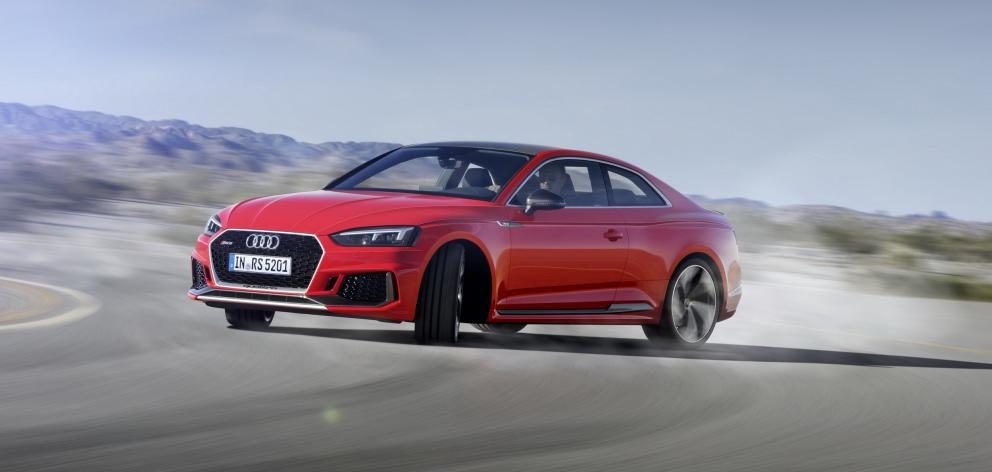
The sound has changed, but not so the shove. Going down to a smaller calibre hasn't affected the firepower of Audi's other big-gun coupe.
Previously a big bore V8 and now a smaller capacity twin-turbo V6, the RS5 still has all the wallop you could wish for.
There are more pluses. Aside from addressing the environmental and economy concerns that triggered Audi to oust its famously fab naturally-aspirated 4.2-litre eight-cylinder from duty, the new engine also provides a positive for track-driving pleasure.
Logic suggests the loss of a pair of cylinders over the front axle would have to have good effect on weight distribution. And logic is bang on.
The old car - surefooted and grippy when pushed hard - imparted a sense of being heavy in the nose and steering.
The V6 is less afflicted. Yes, there are the usual traits expected with any all-wheel-drive car, yet on the Hampton Downs circuit, where Audi allowed high-speed running behind a V10 R8 chase car driven by Tom Blomqvist, a young low-key but fast-rising New Zealand-based talent whose dad - Stig Blomqvist - will be well-known to rally fans, it felt better balanced and more confidence-inspiring. The steering is more faithful and accurate, too, with sharpened, predictable turn-in. There's even a degree of "natural" feedback.
This probably just isn't solely the effect of a smaller, lighter engine; it also has a new chassis
which is stiffer and also delivers kilo savings. But the end result is that it is good.
As it needs to be. So much is at stake. The RS brand is big in New Zealand, where it accounts for 12% of Audi volume, an astounding penetration. Add in the "first step'' S cars and that becomes a 20% slice.

This is not a straight transplant, however, insofar that while the engine is shared, the transmission is not. This RS5 has an automatic ZF transmission rather than continuing with a dual-clutch unit because, Audi says, the V6 makes more torque than any of its own dual-clutch automatics can handle. Yet, of course, in the Panamera the self-same unit happily matches up to PDK - a dual clutch box. There's suggestion that Audi had to make other arrangements because Porsche won't share its own transmission.
Will this become an issue? Hard to see it. The ZF shifts really smartly, doesn't mind being hand-shifted (with paddles behind the steering wheel) and was certainly smoother - or, at least, less jolty - than the dual clutch unit in the RS3 hatch we also had opportunity to drive at Hampton. Step off is faster, too. For the most part, you'll do well to notice any difference whatsoever.
More about this engine. Audi estimates 0-to-100kmh at 3.9sec, which is slightly more than the previous car managed. It's definitely a heck of a hard charger, with power, torque, and speed coming in a huge wave and there's pleasing flexibility to the muscularity. It's more V8-ish than the old V8 in that peak torque arrives at 1900rpm - whereas, with the 4.2, the pinnacle was at 4000rpm - and sticks around until 5000rpm, a broad swath of oomph makes it feel sensationally quick, almost anywhere in the rev range.
It stays true to history with a booming soundtrack, too, notably in the uber-sporty Dynamic mode. The story goes that the engineer in charge was given a first gen RS4 (the one with the turbocharged 2.7-litre V6) and commanded to ``make it sound like that''.
The body shape alters to suit the new mood; leaner and also a touch more muscular, due to flared wheel arches said to be inspired by its old 90 quattro IMSA GTO and under which 20-inch alloys reside. A prominent `egg crate' grille and a pair of cricket ball-swallowing oval exhaust finishers also enhance an air of brutish aggression.

Offering more immediate value to the driving experience is the torque-vectoring sport differential ($3800) that promises the ability to ensure maximum thrust to the ground when the car is booted out of a turn. The default split is 40% front and 60% rear; if the car detects slip, up to 85% can be sent forward, or 70% aft.
The interior delivers RS-specific changes like deeper and heavier bolstered seats, a chunky, flat-bottomed steering wheel, lots of perforated and contrasting stitched leather - and Alcantara on the wheel rim - but it's all five-star, with all the regular car's tech including the swank Virtual Cockpit, albeit with RS-specific displays.
The driving position and the forward view from the supportive, multi-adjustable and massaging front seats is outstanding. Visibility to the rear is decent, too, given the coupe roofline, and the cabin will accommodate four people of average height with no issues.
- Richard Bosselman
| Audi RS5 |
| SPECIFICATIONS |
| Price: $152,900. |
| Engine: 2894cc twin-turbocharged six-cylinder, maximum power 331kW@5700rpm, maximum torque 600Nm@1900- |
| 5000rpm. |
| Transmission: Eight-speed automatic. |
| Brakes and stability systems: Front and rear disc brakes, ABS, EBD, TC, ESC. |
| Safety rating: Not yet NCAP tested. |
| Wheels and tyres: Alloy wheels, 275/30 R20. |
| Fuel and economy: 8.7 litres per 100km, capacity 58 litres. |
| Emissions: 197 grams of CO2 per kilometre. |
| Dimensions: Length 4723mm, width 1861mm, height 1360mm. |
